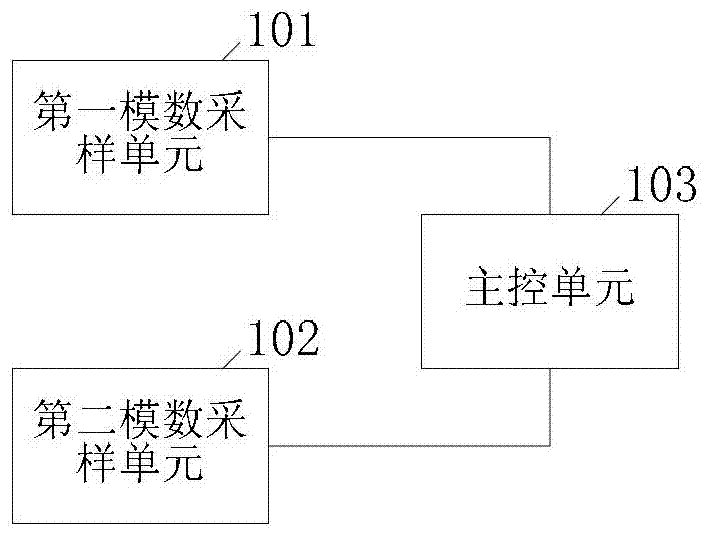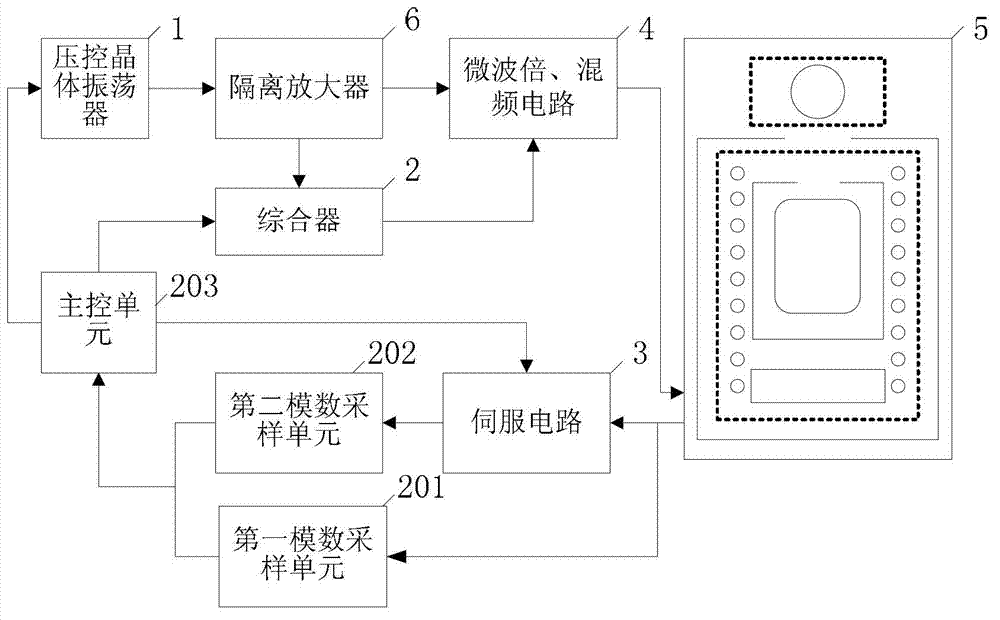Signal to noise ratio evaluation device and method for rubidium atomic frequency standard
A technology of rubidium atomic frequency standard and signal-to-noise ratio, which is applied in the field of signal-to-noise ratio evaluation device of rubidium atomic frequency standard, can solve the problems of complicated measurement process, inaccurate signal-to-noise ratio of rubidium atomic frequency standard, difficulty in installing other equipment, etc. Streamline the evaluation process, improve accuracy, and save resources
- Summary
- Abstract
- Description
- Claims
- Application Information
AI Technical Summary
Problems solved by technology
Method used
Image
Examples
Embodiment 1
[0047] see figure 2 , Embodiment 1 of the present invention provides a signal-to-noise ratio evaluation device for a rubidium atomic frequency standard, and the device specifically includes: a first analog-to-digital sampling unit 101 , a second analog-to-digital sampling unit 102 and a main control unit 103 .
[0048] Wherein, the first analog-to-digital sampling unit 101 is used to collect the frequency discrimination signal output by the physical system 5 under the action of the unmodulated microwave inquiry signal.
[0049] Wherein, the second analog-to-digital sampling unit 102 is used to collect the voltage control signal of the frequency discrimination signal output by the physical system 5 under the action of the modulated microwave interrogation signal, which is phase-locked by the servo loop 3 .
[0050] Wherein, the main control unit 103 is used to output the first frequency sweep voltage and the second frequency sweep voltage to the voltage-controlled crystal osci...
Embodiment 2
[0054] see image 3 Embodiment 2 of the present invention provides a signal-to-noise ratio evaluation device for a rubidium atomic frequency standard, which includes a first analog-to-digital sampling unit 201 , a second analog-to-digital sampling unit 202 and a main control unit 203 .
[0055] Wherein, the first analog-to-digital sampling unit 201 is respectively connected with the physical system 5 and the main control unit 203, and is used for collecting the frequency discrimination signal output by the physical system 5 under the action of the unmodulated microwave inquiry signal. The unmodulated microwave interrogation signal is generated by the output signal of the voltage-controlled crystal oscillator 1 and the single-frequency signal output by the synthesizer 2 after being processed by the microwave multiplying and mixing circuit 4 .
[0056] Wherein, the second analog-to-digital sampling unit 202 is respectively connected with the servo loop 3 and the main control uni...
Embodiment 3
[0072] see Figure 7 , Embodiment 3 of the present invention provides a method for evaluating the signal-to-noise ratio of a rubidium atomic frequency standard, the method specifically includes:
[0073] 301: Output the first frequency sweep voltage to the voltage-controlled crystal oscillator, so that the voltage-controlled crystal oscillator outputs a frequency-changing signal; and collect a frequency discrimination signal output by the physical system under the action of the unmodulated microwave inquiry signal.
[0074] Wherein, the unmodulated microwave interrogation signal is generated by the output signal of the voltage-controlled crystal oscillator and the single-frequency signal output by the synthesizer after being processed by a microwave multiplier and mixing circuit.
[0075] Wherein, the first frequency sweep voltage and the frequency discrimination signal form a one-to-one correspondence.
[0076] 302: Output the second sweep voltage to the voltage-controlled cry...
PUM
 Login to View More
Login to View More Abstract
Description
Claims
Application Information
 Login to View More
Login to View More - R&D
- Intellectual Property
- Life Sciences
- Materials
- Tech Scout
- Unparalleled Data Quality
- Higher Quality Content
- 60% Fewer Hallucinations
Browse by: Latest US Patents, China's latest patents, Technical Efficacy Thesaurus, Application Domain, Technology Topic, Popular Technical Reports.
© 2025 PatSnap. All rights reserved.Legal|Privacy policy|Modern Slavery Act Transparency Statement|Sitemap|About US| Contact US: help@patsnap.com



